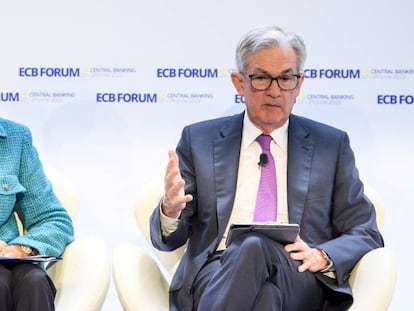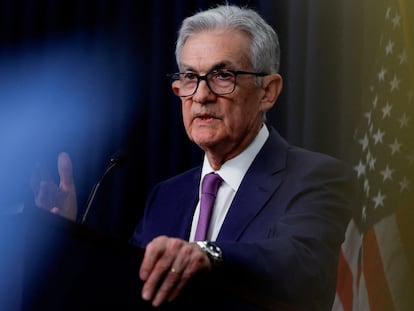Fed minutes confirm that no rate cuts are imminent
Most participants pointed to risks of lowering interest rates too quickly, according to documents


The minutes of the Federal Reserve’s monetary policy committee meetings are always revealed late. And when the economy is, as it is now, at a turning point, a three-week drag can be a long time. With that caveat, the minutes from its January 30-31 meeting confirm the message already delivered by Federal Reserve Chairman Jerome Powell: rates have peaked, their next move will be down, but that is not imminent. Add to each of these statements the adverb “foreseeably”.
Powell usually gives a good summary of the meetings, but their minutes add valuable nuance. On this occasion, most of the Fed’s message sounds familiar, but the minutes include an explicit warning against rushing too quickly into rate cuts: “Some participants noted the risk that progress toward price stability could stall, particularly if aggregate demand strengthened or supply side healing slowed more than expected. Participants highlighted the uncertainty associated with how long a restrictive monetary policy stance would need to be maintained. Most participants noted the risks of moving too quickly to ease the stance of policy and emphasized the importance of carefully assessing incoming data in judging whether inflation is moving down sustainably to 2%. A couple of participants, however, pointed to downside risks to the economy associated with maintaining an overly restrictive stance for too long.”
Other than that, the content addressed in the minutes has already been disclosed. Committee members believe that interest rates have likely already peaked in this monetary policy tightening cycle. However, they do not expect it to be appropriate to lower rates until they have “greater confidence that inflation is moving sustainably toward 2%,” state the minutes, a message that was picked up nearly verbatim in the statement published the same day, and Powell’s speech.
“Participants noted that the future path of the policy rate would depend on incoming data, the evolving outlook, and the balance of risks,” they continue. At the meeting, the Feb kept rates at 5.25%-5.5%, their highest in nearly 23 years, in effect since July.
Powell’s message at the press conference has already led to the ruling out of the first rate cut in March. “We will need to see continuing evidence to build confidence that inflation is moving down sustainably to our goal,” he said at the time. For now, that evidence has not yet materialized. Although it is not the Fed’s most closely watched gauge of inflation, the consumer price index (CPI) fell less than was expected in January, to 3.1%, when the market expected a fall of 3.9%. In addition, core inflation remained steady at 3.9%. The monetary policy committee will act on data, and this data doesn’t help.
With all this in mind, most investors and analyst continue to expect three 0.25-point rate cuts this year (as forecasted by the Fed in December), one per quarter, starting in the second quarter. Part of the market is still betting that the first cut will come on May 1, but more and more experts are looking to the June 10-11 meeting, in view of the strength of the economy.
The United States expects to return to the Moon on Thursday, after more than a half century, if the spaceship Odyssey is able to land successfully. A smooth landing, a term that, as Alan Greenspan explained in his memoirs, comes directly from the space race, is also the goal of Powell, who just one year ago considered the task of getting inflation under control without triggering a full-blown recession to be a difficult one. Now, there is a visible path towards doing just that, but the last mile of the fight against price hikes is getting to be a little more complicated that expected. No one is claiming victory just yet.
The Fed is also facing a turning point when it comes to interest rates, with political pressure in both directions. Although the President of the United States, Joe Biden, is respectful of the role played by the central bank, some Democratic Party leaders have urged Powell to lower the price as money as soon as possible. On the other hand, the likely Republican candidate, Donald Trump, has accused Powell of supporting Biden’s re-election, and has warned that, if Trump manages to return to the White House, he will not renew Powell’s mandate.
Powell took office as chairman of the Federal Reserve in 2018 after being appointed by Trump himself. Then in 2022, under Biden’s presidency, he was sworn in for a second term, which expires in May 2026.
The Federal Reserve sets monetary policy at joint meetings of the Board of Governors and the central bank’s Federal Open Market Committee (FOMC). The FOMC has 12 voting members: the seven members of the Board of Governors, the president of the Federal Reserve Bank of New York, and four of the 11 remaining Reserve Bank presidents, who serve one-year terms on a rotating basis. The presidents of the other Reserve Banks attend committee meetings and participate in discussions, but do not have voting rights. The sessions tend to be crowded, with about a hundred attendees, mostly economists, technicians and advisors.
Technicians tend to speak first, starting with the manager of the system’s open market account (SOMA), who explains the current financial and monetary situation. Economists from the Federal Reserve’s research department provide their assessment of the economic situation. This is usually followed by a discussion among the committee members on the best course of action.
Sign up for our weekly newsletter to get more English-language news coverage from EL PAÍS USA Edition
Tu suscripción se está usando en otro dispositivo
¿Quieres añadir otro usuario a tu suscripción?
Si continúas leyendo en este dispositivo, no se podrá leer en el otro.
FlechaTu suscripción se está usando en otro dispositivo y solo puedes acceder a EL PAÍS desde un dispositivo a la vez.
Si quieres compartir tu cuenta, cambia tu suscripción a la modalidad Premium, así podrás añadir otro usuario. Cada uno accederá con su propia cuenta de email, lo que os permitirá personalizar vuestra experiencia en EL PAÍS.
¿Tienes una suscripción de empresa? Accede aquí para contratar más cuentas.
En el caso de no saber quién está usando tu cuenta, te recomendamos cambiar tu contraseña aquí.
Si decides continuar compartiendo tu cuenta, este mensaje se mostrará en tu dispositivo y en el de la otra persona que está usando tu cuenta de forma indefinida, afectando a tu experiencia de lectura. Puedes consultar aquí los términos y condiciones de la suscripción digital.
More information
Archived In
Últimas noticias
Most viewed
- Reinhard Genzel, Nobel laureate in physics: ‘One-minute videos will never give you the truth’
- Pablo Escobar’s hippos: A serious environmental problem, 40 years on
- Charles Dubouloz, mountaineering star, retires at 36 with a farewell tour inspired by Walter Bonatti
- Why we lost the habit of sleeping in two segments and how that changed our sense of time
- The fall of a prolific science journal exposes the billion-dollar profits of scientific publishing










































